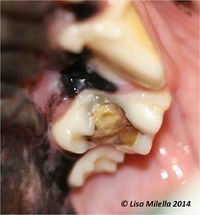Dental Caries
Introduction
Caries = tooth decay.
Dental caries is a plaque-induced demineralization of the teeth caused by the action of cariogenic bacteria on fermentable carbohydrates. The acid which is produced demineralizes the enamel and dentine. Bacteria is then able to invade the dentine and dentinal tubules, undermining the enamel and eventually causing the collapse of the enamel and cavitation of the tooth. The occlusal surfaces of the molar teeth are particularly prone to caries.
Dental caries is a multi-factorial disease which requires all four of the following:
- Susceptible tooth surfaces
- Fermentable carbohydrate source
- Cariogenic bacteria (ie. Streptococci and Lactobacillus)
- Time
The occurence of dental caries is low in dogs when compared with humans. There are thought to be several reasons for this such as the fact there are fewer cariogenic bacteria in the normal oral flora and a higher salivary pH, acting to neutralize acid produced by the bacteria. Also, canine tooth surfaces are not prone to food impaction and their diets are normally low in fermentable carbohydrates. Dogs also have a lower frequency of food intake compared with humans.
Aetiology
Caries is an organic demineralization of tooth substance. It is caused initially by acidic metabolites produced during breakdown of simple sugars by specific bacteria (Streptococcus mutans and S.sanguis). Once the enamel has been eroded and the dentine is reached, the destructive process seems to be enhanced. Caries most frequently occurs in the pits and fissures of the molar teeth .
Signalment
Not uncommon in dogs and never really been diagnosed in cats. Dental caries can occur in any breed or size of dog. There is a greater risk of the condition with salivary gland dysfunction or dehydration as well as with diets high in fermentable carbohydrates or simple sugars.
Clinical Signs
These may include dysphagia, reluctance to eat, tooth pain and thermal sensitivity, excessive salivation, bad breath and pain on mastication. There may also be weight loss and the dog may appear generally depressed and lethargic.
Diagnosis
Clinical signs and history will indicate an oral issue. A full physical examination should follow. If a full dental examination is required to examine the extent of the problem, this is usually done under anaesthesia.
Dental examination will show the tooth surface to have the presence of a 'white spot' (early lesions) or a brown/grey discolouration (advanced lesions) of the tooth surface. Severe lesions may present with a cavitation of the tooth surface. A sharp dental probe can be gently used to identify defects in the tooth surface. The probe will stick when removed from a carious lesion due to the softened dentine.
Radiographs of the tooth may show a radiolucency within the tooth or below the occlusal surface. The extent of lesions may be underestimated as a 40% loss of mineral content is required before a radiolucency is seen on a radiograph. In addition this means that advanced lesions are also more difficult to interpret.
Treatment
Factors that have contributed to the formation of the caries should be assessed and addressed. These may include diet (reduce amount of fermentable carbohydrate), salivary gland dysfunction and the anatomical structure of the tooth such as deep pits and fissures on the tooth surface.
Non-cavitated white spot lesions may remineralise and require conservative treatment such as dietary advice and home dental care focusing on plaque control by methods such as brushing teeth or using dental chews. These dogs will also require regular check-ups and assessments.
Cavitated lesions may require restorative treatment, which may involve removal of diseased enamel and dentine and the placement of restorative material such as composite resin or glass ionomer. Extraction may be required if there is extensive loss of the tooth structure.
| Dental Caries Learning Resources | |
|---|---|
To reach the Vetstream content, please select |
Canis, Felis, Lapis or Equis |
References
Blood, D.C. and Studdert, V. P. (1999) Saunders Comprehensive Veterinary Dictionary (2nd Edition) Elsevier Science
Tutt, C., Deeprose, J. and Crossley, D. (2007) BSAVA Manual of Canine and Feline Dentistry (3rd Edition) BSAVA
| This article has been peer reviewed but is awaiting expert review. If you would like to help with this, please see more information about expert reviewing. |
Error in widget FBRecommend: unable to write file /var/www/wikivet.net/extensions/Widgets/compiled_templates/wrt695e90cdb261b8_10085428 Error in widget google+: unable to write file /var/www/wikivet.net/extensions/Widgets/compiled_templates/wrt695e90cdb90812_78555192 Error in widget TwitterTweet: unable to write file /var/www/wikivet.net/extensions/Widgets/compiled_templates/wrt695e90cdbf5be9_68792012
|
| WikiVet® Introduction - Help WikiVet - Report a Problem |
